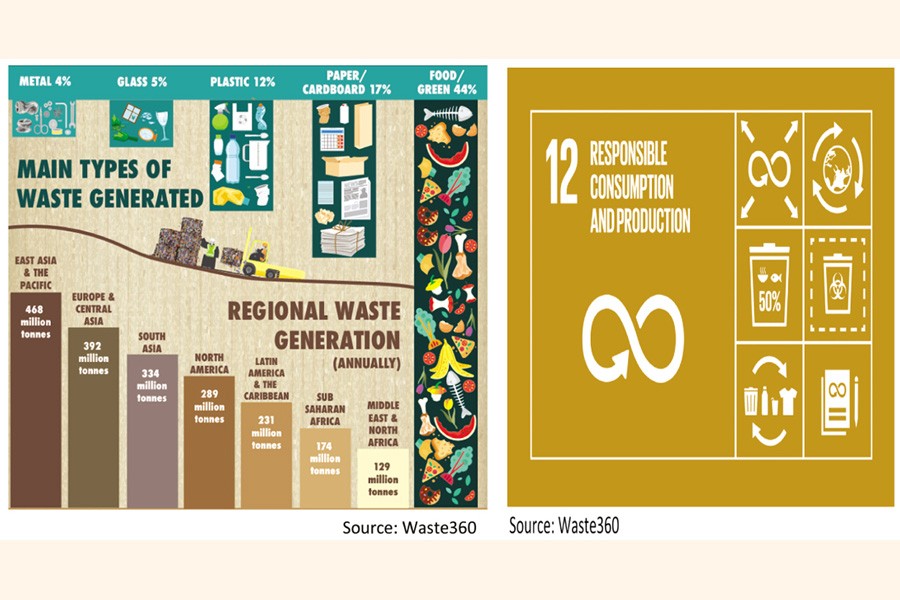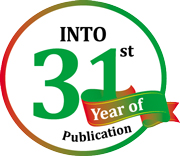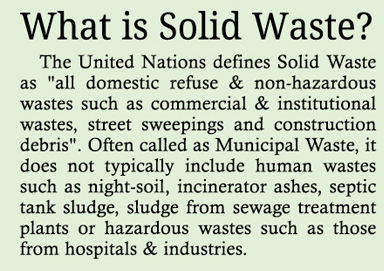
 While attending lectures on Solid Waste Management (SWM) as part of my Master’s in Urban (Environmental) Management and Development at Rotterdam back in 2007, I was first introduced to the concept of solid waste and the need for its management, especially at urban levels. I was told that solid waste is both a ‘big’ problem and a ‘golden’ prospect, which however, was hard for me to grasp at first, specifically for me being an architect interested in everything that is ‘beautiful’. In the following year, in 2008, an Oscar-winning film called Wall E presented an apocalyptic image of a future planet Earth contaminated by trash, long discarded by people. These two moments hit me hard and I started looking at my surroundings in a different light.
While attending lectures on Solid Waste Management (SWM) as part of my Master’s in Urban (Environmental) Management and Development at Rotterdam back in 2007, I was first introduced to the concept of solid waste and the need for its management, especially at urban levels. I was told that solid waste is both a ‘big’ problem and a ‘golden’ prospect, which however, was hard for me to grasp at first, specifically for me being an architect interested in everything that is ‘beautiful’. In the following year, in 2008, an Oscar-winning film called Wall E presented an apocalyptic image of a future planet Earth contaminated by trash, long discarded by people. These two moments hit me hard and I started looking at my surroundings in a different light.
Only at a later point in my professional life, did the deep implications of SWM begin to make sense. In several urban planning/ design/development projects in which I advised or got involved, I came to realise that the urban environmental crisis, to a great extent, is affected by the depths and breadths of challenges emanating from trash and its management failure. It tends to occur more in cities where population concentration is higher, built-up areas outdo natural areas, waste management institutions (like city corporations and pourashavas in Bangladesh) remain weaker, and people’s waste dumping behaviours are uncontrolled.
Weighing in the urban trash problems
Globally, about 2.2 billion tonnes of solid waste is produced per annum, which contributes to at least 5 per cent of total greenhouse gas emissions as well. With newfound affluence from continuing economic growth in middle-income nations and growing economic aspirations of lower-income nations in Asia and Africa and hence growing consumerism, this volume is expected to rise to 3.4 billion tonnes by 2050. Additionally, electrical and electronic waste (e-waste), often containing complex hazardous substances, has appeared as the fastest-growing challenge in both developing and developed worlds since the beginning of this millennium. Statistics show that the total e-waste produced in 2022 was about 60 million tonnes – almost double the volume of 33 million tonnes produced in 2010. At this present rate, it should easily surpass a billion tonnes by 2050. A large amount of e-waste produced in the West also often ends up in the global south’s second-hand market.
Typology of urban waste
With high population concentration and varied consumption patterns, urban areas play a prime role in waste generation. Especially the cities and towns in the developing nations, despite having a lower waste generation rate compared to their developed world counterparts, are increasingly becoming party to this. But even with a lower waste generation rate (0.80kg/person/day), compared to the developing world (2.5kg/person/day), the lion’s share of total global waste generation can already be attributed to the non-Western nations.
The composition of solid waste in developing world cities varies based on urbanisation rate and trend, economic activities specific to the city, urbanites’ lifestyle and culture, and waste management practices by urban institutions. Although the following list of various solid waste is not exhaustive, typically this includes (1) organic waste such as kitchen and food waste; (2) single-use plastics (e.g. pet bottles), all types of packaging materials and plastic products; (3) paper, cardboard, waste paper, and packaging; (4) metals that include discarded metal items, cans, and another packaging; (5) glass bottles and containers; (6) discarded clothing, fabrics and other textiles; (7) electronic waste, such as old electronics and appliances; and (8) debris from construction and demolition sites.
Challenges for urban waste management
While the failure of urban waste management creates significant urban environmental challenges, the very act of managing urban waste is also seriously affected by several key issues. Especially in cities like those in Bangladesh, some typical problems may be highlighted.
Environmental pollution and health hazards: people’s insensitive waste disposal practices, such as dumping into water bodies and open incineration, result in soil, air and water pollution, and cause health hazards. The widespread use of single-use plastics, as said earlier, impacts water quality, disrupts water flow and reduces depth and soil fertility. The increasing use of electronic gazettes and appliances in recent times contributes to an even bigger challenge of e-waste.
 Governance and institutions: these local bodies often fail to adhere to any management principle like the 3R (Reduce-Reuse-Recycle), and struggle to determine whether they should adapt to a decentralised or centralised waste management system. They frequently depend on donor and NGO support, and adopt their prescriptions uncritically. These institutions often lack implementing and enforcing regulations (and power) related to waste management and depend heavily on other departments, including waste segregation, recycling and disposal standards. Often there is a lack of awareness among the citizens regarding proper waste disposal behaviour and practises the importance of recycling and efforts from municipalities to train and raise awareness. Involving local communities in waste management through their active engagement and participation has been rare too. Often, a lack of coordination between plan-preparing agencies (like RAJUK) and service delivery bodies (like DNCC, and KCC) affects the planning and design of waste management infrastructure.
Governance and institutions: these local bodies often fail to adhere to any management principle like the 3R (Reduce-Reuse-Recycle), and struggle to determine whether they should adapt to a decentralised or centralised waste management system. They frequently depend on donor and NGO support, and adopt their prescriptions uncritically. These institutions often lack implementing and enforcing regulations (and power) related to waste management and depend heavily on other departments, including waste segregation, recycling and disposal standards. Often there is a lack of awareness among the citizens regarding proper waste disposal behaviour and practises the importance of recycling and efforts from municipalities to train and raise awareness. Involving local communities in waste management through their active engagement and participation has been rare too. Often, a lack of coordination between plan-preparing agencies (like RAJUK) and service delivery bodies (like DNCC, and KCC) affects the planning and design of waste management infrastructure.
Urban planning and infrastructure: developing nations have been experiencing rapid urbanisation for the past 5-6 decades, leading to an increased rate of waste generation owing primarily to very high population growth, changing consumption patterns of urban citizens and rapid industrialisation. Coupled with land scarcity, these overwhelm local urban planning, as the rate of urbanisation often supersedes the speed of urban plan preparation. Even in planned cities like Dhaka, and especially its residential neighbourhoods developed by RAJUK let alone those developed by private and informal sectors, it is hard to find a properly planned waste management system and correctly located waste collection/sorting station (Secondary Transfer Station or STS). In smaller cities like Khulna or Faridpur, even dedicated locations for STS and similar facilities remain a rarity to this day. In cities, big or small, land and resource allocation for waste management (e.g. collection and/or source separation) have not been commonplace. They often have limited financial resources to invest in modern waste management technologies and infrastructure, hindering the creation of efficient waste collection and disposal systems.
These deficiencies in planning (response) and resources are further compounded by inadequate research and availability of data on the exact quantity and type/nature of waste generation. Such (lack of) understanding affects infrastructure planning for waste collection, handling/sorting, storage, transportation, processing and disposal. For local public service delivery bodies like city corporations and pourashavas, planning for both hard and soft infrastructure remains tricky. These bodies struggle to determine the appropriate resources to be mobilised and infrastructure to be erected and deployed. While hard infrastructure like STS and waste handling equipment like garbage trucks and excavators remain essential, they struggle to decide whether and how much they should invest in these or invest instead in soft infrastructure like three/four-bin systems for source separation, door-to-door collection using small rickshaw van or a combination of both hard and soft infrastructure or citizen’s awareness raising.
Barriers to recycling: limited economic incentives for waste recycling impede the effectiveness of recycling. Establishing systems that make recycling economically viable also remains a challenge in many developing nations like Bangladesh. Further, while informal waste collectors play a key role in recycling, their health and safety issues and the standards of these workers remain a concern. As mentioned previously, e-waste management is presently posing unique challenges due to the presence of hazardous materials and highlighting the need for specialised recycling regulations and facilities.
Climate change: in climate-vulnerable cities like Khulna or Patuakhali, poor waste management practices exacerbate climate change-induced flooding and waterlogging. Often major canals, rivers and both natural and engineered drainage channels are filled in and water is obstructed by thick layers of erratically dumped plastic waste. Climate change also often affects the structural quality of waste management infrastructure. Climate change-induced salinity increase in the coastal cities often decreases the lifecycle of this infrastructure, while its operation and maintenance costs increase due to their accelerated deterioration. Sea level rise (SLR) leaves its impact on landfill sites and waste recycling facilities located near coastlines or tidally active riverplains, which become prone to the risk of inundation and flooding, triggering environmental contamination and the release of pollutants into all adjacent water bodies.
Waste management: how are we doing?
Sustainable waste management typically involves a seven-stage process that includes: (1) refusing to buy wasteful or non-recyclable products; (2) reducing waste at source; (3) reusing waste; (4) repurposing; (5) recycling; (6) recovery; and (7) disposal.
This process is similar to what is suggested in Bangladesh’s recently published Solid Waste Management Rules 2021, which, however, almost echoes the same approach of SDG 12. Although Rule 2021 holds users and waste producers responsible, most emphasis is given to the role of urban institutions in charge of waste management, i.e. the local government bodies like Dhaka North City Corporation. It stresses the mandatory preparation of a SWM Master Plan for each such body, implementing a 3-bin source separation system for waste collection, storage and transportation, recovering resources like composts, biogas, biofuel, electricity etc., and disposal through safe sanitary landfill or incineration. Among others, Rules 2021 also highlights the need for public awareness and information dissemination.
In terms of tangible action on the ground, the present trend of waste management in Bangladesh, despite sporadic efforts, has been more toward chasing the typically easier route of disposal and landfilling, instead of those sustainable ones highlighted by SDG 12 and Rules 2021. Beginning with the waste management master plan, only a handful of large and financially solvent city corporations (e.g. DNCC, DSCC, NCC, CCC) have recently drafted some form of master plans with major observations on their quality and content, while many medium and smaller urban centres still lacking a proper land use master plan, let alone one dedicated for waste management.
Having a master plan is one thing, and its proper realisation is another. For example, DNCC’s master plan is called “Environmentally Advanced City with Integrated and Sustainable Solid Waste Management: Towards Zero-Waste. NEW CLEAN DHAKA. MASTER PLAN 2018-2032”. However, it is known that DNCC has already scrapped the eco-city component and is considering the implementation of only its selected portions of the plan. There still is scepticism about the amount of electricity to be produced from the very wet organic content, while the ‘zero-waste’ part seems almost impossible as some landfill sites would still be required to get rid of the post-recycling residue. Outside Dhaka, even this level of quality seems tough. In the case of NCC (Narayanganj City Corporation), and looking at their master plan, one immediately observes the disconnect between SDG 12, Rules 2012 and the seemingly hurriedly prepared master plan for waste. This document lacks a concept, the policies are vaguely written, while any social component of the management plan has been hardly articulated.
None of these master plan documents outlines any principle, planned pathway or actions for most of the R’s (refuse, reduce, reuse, repurpose and recycle). The issues of refusal and reduction are hardly spoken of. How could organisations and individuals be able to practise these in their everyday acts, who would make sure of its lawful execution, what alternatives would they have, what additional resources would be required, how could they afford this, and to accomplish what goals, are hardly addressed. Instead, they take for granted the informal approaches and informal sector’s activities to reuse and recycle, and as mentioned earlier, pursue the centralised approach for waste management – based largely on disposal through landfilling and incineration.
Where do we go from here?
Sustainable solid waste management, especially the reuse and recycling of waste, so far in Bangladesh, has been largely dependent on the informal trail. Despite low overall harnessing (hence recovery) from all waste types, the economy of trash in Bangladesh has grown into a multi-million-dollar sector, which is driven primarily by the initiatives of the petty informal sector and SMEs but nearly unaccounted for. “One man’s trash is another man’s treasure”, the common saying goes. But so far, this treasure has been poorly harnessed, while its full potential is hardly recovered by the formal sector and transformed into useful resources like bio-fuel, energy and organic fertiliser. An overall weakness in the solid waste management sector, especially from the local government’s side and without the inclusion of the private formal sector, it could not possibly become a multi-billion-dollar sector.
“Pollution is nothing but the resources we are not harvesting” claimed Bucky Fuller in the early 1900s, the famous American engineer cum scientist, “We allow them to disperse because we’ve been ignorant of their value”. In Bangladesh, even if we have recognised the potential of this sector, we have mostly been ignorant of its true value for the economy and environment alike. Especially in the quest for the survival of our loved planet Earth, sustainable waste management is a must. This is quite strongly advocated by the tenets of circular economy now, arguing ever strongly in favour of keeping our footprint within a circle, preferably by doing all kinds of Re’s (re-use, re-cycle etc.) and thus reducing the need for further harnessing of our planet’s scarce resources.
Seemingly impossible it may appear considering a growth-based economic model that feeds on consumerism, but good examples are also plenty. In many European nations, especially in the Scandinavian ones, waste-to-energy has been one of the key sources of electricity for more than a decade now. Many waste-recycling centres, like Copenhill: Amager Bakke in Copenhagen, are serving as key learning cum recreational centres right in the middle of cities. Authorities began to realise that the money spent on waste dumping could be saved by spending similar amounts on recovering resources.
In Bangladesh, door-to-door waste collection has been a quite successful model in terms of separation and collection of household waste. It also provides employment opportunities for many. Award-winning NGOs like Waste Concern, which was founded in 1995 with the slogan “Waste is a Resource”, has now become a role model for many next-generation NGOs and organisations. Although unsuccessful so far, waste to fuel is already being tried even in smaller towns and cities in Bangladesh (like Jashore and Khulna) providing important lessons for future directions and possible investments. HBRI, a few years back, successfully attempted building with construction waste. Byproduct businesses such as Jhut, bones and recently typically thrown-away fish scales, have been providing livelihoods to thousands if not millions and earning revenue. These unexplored territories of recycling, notwithstanding the potential of other more traditional sectors, show that the ever-so-wasteful garbage, can certainly become gold! A coordinated effort at the institutional level, engagement of private sectors and SMEs, and responsible citizenship are all that are required.
Sheikh Serajul Hakim is an educator and architect based at Architecture Discipline, Khulna University, Bangladesh. He can be reached at: serajulhakim@arch.ku.ac.bd
© 2026 - All Rights with The Financial Express
